Apple 154 Macbook Pro With Touch Bar (Late 2016 Space Gray) Reviews
AppleInsider is supported by its audition and may earn commission as an Amazon Associate and affiliate partner on qualifying purchases. These affiliate partnerships exercise not influence our editorial content.
Apple tree's new Belatedly 2016 15-inch MacBook Pro is the lightest and thinnest MacBook Pro e'er, but unlike the visitor'due south earlier ultralight MacBook Air, information technology packs a fast, quad-core Intel CPU and a dedicated AMD Radeon Pro GPU along with 16GB of high speed RAM and other "pro" level niceties. After spending some time with the new flagship, AppleInsider came away impressed at what Apple tree was able to accomplish.
The new high stop Mac notebook delivers half dozen major categories of enhancements over previous models, beyond its new thinner, lighter frame:
- The new Touch Bar, a dynamic input device that replaces the summit row of static F-keys above the keyboard, offer quick access to Control Strip buttons, QuickType keyboard (and emoji) suggestions and contextually relevant app-specific controls that alter based on the selected context
- Fast Intel quad core Cadre i7 Skylake CPU options paired with very fast 2133 MHz PC3-17000 LPDDR3 SDRAM and a AMD Radeon Pro 450/455/460 defended GPU backed by 2 or 4GB of GDDR5 memory and automatic switching to a more power efficient Intel HD Graphics 530 GPU
- Ultra fast PCIe-based SSD storage of upwards to 2TB
- Iv versatile USB-C expansion ports that back up up to two 5k or four 4k external DisplayPort monitors (as well every bit VGA, HDMI and Thunderbolt two displays with an adapter cablevision) too as USB 3.1 Gen ii devices (up to 10Gbps) and daisy-chained Thunderbolt 3 peripherals (up to 40 Gbps) and power charging
- A new Broad Color Retina Brandish that's brighter and sports higher contrast and the expanded DPI P3 colour gamut and new louder new stereo speakers
- A larger Strength Touch trackpad and enhanced Retina MacBook way butterfly keyboard
How the 15-inch MacBook Pro fits into Apple'due south Tardily 2016 notebook offerings
The latest MacBook Pro models are internally Apple tree's 13th generation MacBook Pro, simply they finer represent the fourth major body redesign. Steve Jobs introduced the outset MacBook Pros at the start of 2006 as an Intel-based version of its existing aluminum beat PowerBooks, one twelvemonth before the iPhone was introduced. Apple originally introduced just the 15-inch model, followed by a huge 17-inch version and smaller 13-inch model over the next year.
A year after iPhone, Apple introduced MacBook Air at the first of 2008, the first unibody Mac design. Afterwards that same twelvemonth, the MacBook Pro line too got unibody frames. Four years later on, Apple discontinued its 17-inch model and moved its MacBook Pro line to Retina Displays, representing the third major redesign. While borrowing manufacturing technology from the MacBook Air and iPad, MacBook Pro models remained a substantial 0.71 inches (xviii mm) thick and the fifteen inch model weighed in at 4.v lbs (two.04 kg).
In its fourth major redesign, the new xv-inch workhorse MacBook Pro slims down to 0.61 inches (15.five mm) and now weighs just four.02 pounds (one.83 kg). That's slightly thinner than last year'south thirteen-inch MacBook Air and only a pound heavier, despite packing a broad range of Pro features and substantially a larger, better, faster everything. That actually reinforces that Apple'southward design intent on the Pro end was to create a truly mobile motorcar more just a transportable desktop alternative.
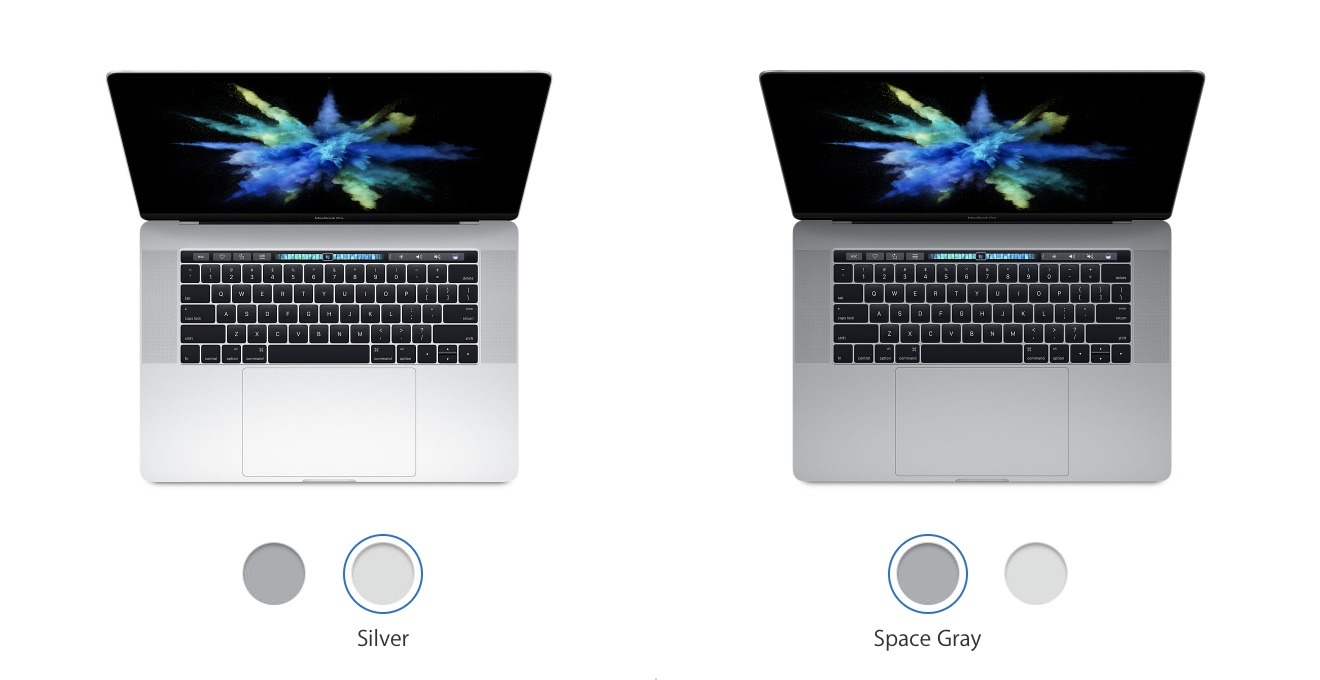
Apple'due south high cease 15-inch MacBook Pro is available in standard Silver and a darker Space Gray finish, and is sold alongside a smaller 13-inch version with many of the same features apart from scaled down CPU options and being express to Intel Iris Graphics and 1TB of SSD storage. Apple tree also offers an entry version of the 13 inch MacBook Pro lacking a Touch Bar and Touch ID and equipped with just two Thunderbolt 3 ports.
The company is also selling its ultralight 12-inch Retina MacBook powered by lower-cease CPUs and with merely a unmarried USB-C (supporting only USB iii) in Silver, Space Gray, Aureate and Rose Gold; information technology also continues to sell the former 13-inch MacBook Air, which lacks a Retina Display and uses full size USB 3 ports and Thunderbolt ii, bachelor in Silver.
While Apple emphasized the light, slim design of the new MacBook Pros at their introduction, information technology focused even more than attending on an entirely new feature making its debut the Mac platform: the new Impact Bar and its Bear on ID fingerprint sensor that takes the identify of the ability push button. Both are controlled by a custom Apple tree T1 chip that pairs the efficient processor used in the Series ii Apple tree Watch and Apple'southward Secure Enclave architecture that authenticates biometric information from modern iOS devices' Abode buttons.
Touch on ID on the Mac, therefore, takes biometric security a lot more seriously than previous generations of Windows laptops that incorporated a fingerprint scanner. Every bit with iOS devices, the Secure Enclave makes it incommunicable for tertiary party apps or even organization-compromising malware to gain whatever access to your fingerprint information.
Every bit implemented on MacBook Pros, the Touch on ID sensor (below, the nighttime foursquare to the correct of the Siri Touch on Bar button) acts as a push, simply you probably won't need to apply it as a push very often. The new machines automatically kick upward or wake when opened (and don't even bother to play a startup chinkle). The button is there to perform an emergency power downward in the example of a organisation crash.
Dissimilar previous MacBook power buttons, pushing information technology no longer offers to sleep, shutdown or log out of the machine. Simply close the lid to slumber. Rather than regularly logging out or shutting down, you can now acquaintance the sensor with 5 unlike fingerprints (your ain, or of other people), which tin be used to wake or to switch between accounts using Fast User Switching.
Note that if you log out of your account, you'll need to supply a password to log back in; Bear on ID only works if your account is active. You also need to log in manually afterwards a ability cycle, just as with iOS devices. This multiple-account, multiple fingerprint behavior is likely to somewhen make information technology to iOS devices, as they become more powerful and as multiple accounts evolve into a complete feature. And so far, Apple has focused on multiple accounts only for education apply.
Touch ID can also be used to instantly unlock Notes yous've locked with a countersign, or other content in third party apps making apply of Apple tree'south security Touch ID APIs. Apple indicates that locked System Preferences can likewise be unlocked with a finger print, but that doesn't seem to be working yet. If you have your machine set up to lock the screen after a moment of inactivity (the default behavior), you can too unlock the screen instantly with a touch. It'due south really, really fast and effortless.
To the left of Touch on ID, the rest of the F-key strip is taken over by Touch Bar, a 2170 pixel past sixty pixel touchscreen brandish designed to function as an input device. Similar the main brandish, it reproduces the Wide Color DCI-P3 gamut with Retina resolution, and it'southward optimized for typical viewing at a 45 degree angle. Apple has devoted a lot of idea into how the Impact Bar should work, equally detailed in its macOS Human being Interface Guidelines
The Touch Bar is intended to appear and role as a dynamic strip of virtual keyboard keys, unconfined by the physical construction of mechanical keys. When you agree down the FN key, the Touch Bar reverts to a standard strip of 12 function keys and the ESC key (below). If y'all kicking into Windows, the Bear upon Bar reverts to displaying virtual FN keys.
![]()
Otherwise, the strip displays 3 pools of functionality: on the right end is a Control Strip of keys offer a mix of conventional alternative MacBook function keys (system volume, media playback, screen and keyboard illumination brightness, Expos buttons and a button to invoke Siri). This strip collapses down to about a quarter of the Touch on Bar in normal use, only a tap on the expansion pointer makes the Command Strip take over the entire Touch on Bar (below). You revert back by tapping the close "10" push.
![]()
Control Strip, expanded to have over the entire Touch Bar
The master portion of the Bear on Bar is used by the electric current application to offer relevant options based on what you're doing or what you've selected. This app region normally exposes the same kinds of buttons that you'd meet in your window Toolbar (like the Mail app, below), but developers can add new controls including sliders, pickers and suggestions that wouldn't really make sense in a window Toolbar.
![]()
Mail puts mutual Tool Bar icons in the Touch Bar, but too a handy folder Motion to control
It also serves as a style to expose functionality that would otherwise exist cached in menus, requiring more mousing around to select. The layout of these app region buttons can normally exist edited from an app'due south View menu, using an interface similar to how you'd customize your Toolbar buttons (below: editing the Finder's Touch Bar). You only drag the icons you lot desire toward the Touch Bar on the main screen, and when finished tap the Done button.
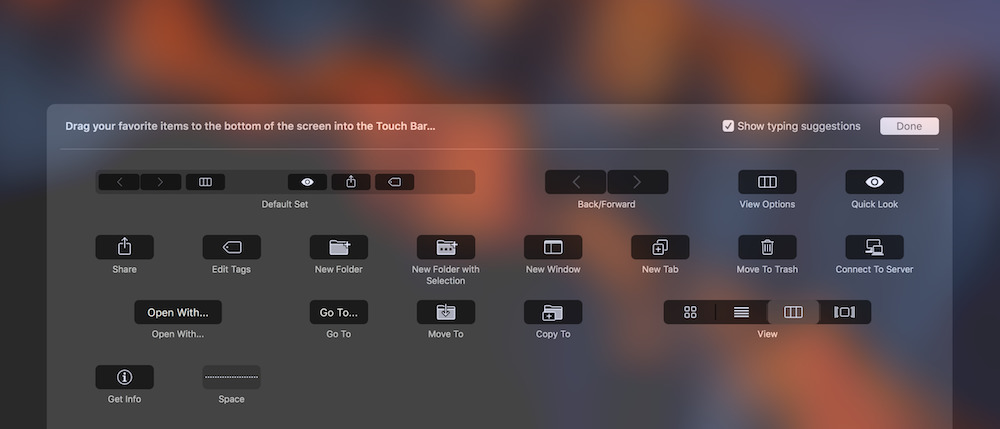
![]()
Editing the Touch Bar within the Finder app
Another feature of the Touch on Bar — which by and large takes over the app region when you lot're typing — is similar to the QuickType keyboard of iOS. It offers completion suggestions on words you lot type (below, "antidisestablishmentarianism"), and is tied into the standard spell checking of macOS, enabling you to select a spelling suggestion past visually tapping on the give-and-take y'all intended, rather than tapping the infinite bar to have the primary suggestion (which in this case would have been "antics").
![]()
This region can also propose emojis as you lot type words (or, below, provide a browsable list of your frequently used emojis or present all the various buckets of emojis: smileys, animals, nutrient, action, places, objects, symbols, flags). The Touch Bar pickers are all much easier to use than the clumsy, existing emoji selection machinery of macOS that relies on keyboard shortcuts and mousing effectually.
![]()
![]()
Additionally, whenever yous have a pick of options in a dialog box, those buttons more often than not bear witness up in the Touch on Bar for easy choice (below). As well — borrowing a page from iOS — macOS now suggests autofill information in spider web forms (such equally suggesting your telephone number, electronic mail or other contact information), and these suggestions similarly announced in the Touch Bar as buttons you can utilize when filling in forms.
![]()
Using the Touch on Bar feels novel and futuristic (call back Star Expedition and those glass control panels of graphics moving around). The options displayed can range from very handy to a bit overwhelming, particularly when yous switch to a less familiar app and have to absorb the options it chooses to expose. There'southward no Organization Preference for turning off the Bear upon Bar, merely it doesn't always seem to actually get distracting, even if you lot're inside an app where it makes less sense to use it. If the constantly changing nature of contextual buttons in the app region gets overwhelming, you can tap to aggrandize the Control Strip and have a fixed set of static black and white buttons.
And despite a study to the reverse, modifier key combinations (such as holding downward Option + Shift when adjusting the volume buttons to modify the setting in smaller increments) besides work with the expanded Command Strip buttons in the new Bear upon Bar. All the same, without expanding the Control Strip, volume controls hibernate behind a single button, which when touched presents a slider control for adjusting the volume, with standard increment buttons on either end.
When groundwork music is playing in iTunes (or another app is playing video or audio), the Touch Bar presents a button that when tapped shows a progress indicator and pause, fast forward and review buttons. There'southward also a red push badged with the currently playing app, which tin be used to bring that app forward (below). Notably, there's no indicator presented in the Touch Bar itself showing the name of the song or other content existence played. However, this does offer a quick, 2 tap style to bring up the currently playing app so you tin come across what's playing.
![]()
This screen shot blurs the background music playback indicator, only it'south the white line between the scarlet iTunes icon and the rails pick/pause buttons
The value of the Touch Bar changes based on the app you're using. When typing Notes, information technology basically serves as just a QuickType proffer field, forth with buttons for basic formatting and Note management. One key new features in Notes, notwithstanding, is lockable Notes. Password protect a Note, and the Touch on Bar directs y'all to authenticate with your fingerprint.
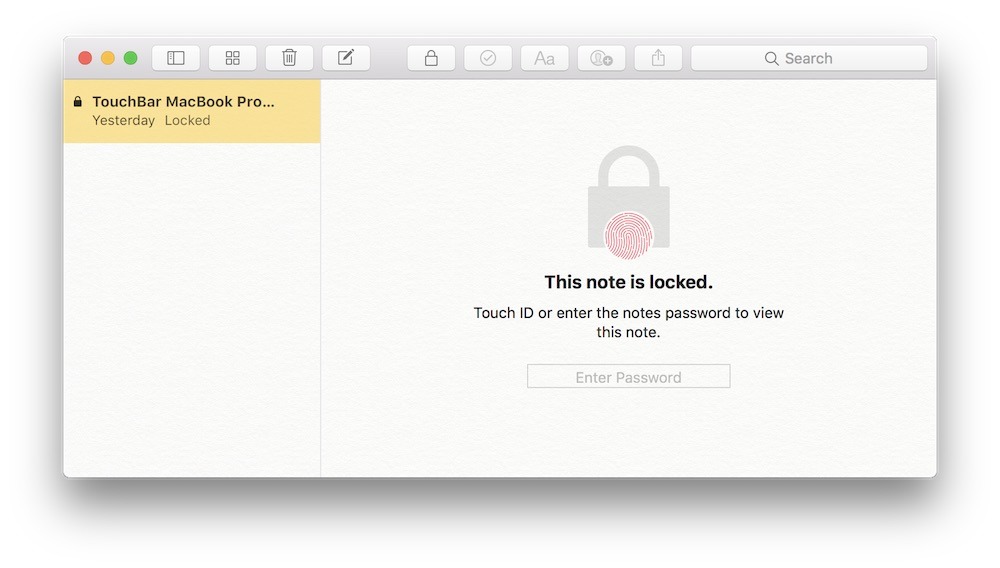
![]()
Some of Apple tree's bundled apps nowadays Touch Bar buttons that let you access nigh all of their bones features from the strip. For instance, Maps lets you search for a variety of common items like nearby restaurants, cafes or gas stations then go directions or look up the location's website, call information technology, favorite it, get more information or share it with merely ii taps of the Touch Bar. Even utility apps like Activity Monitor expose one-tap control to the various tabs of the display, no mousing required at all.
![]()
![]()
Maps' Bear on Bar lets you search for key categories and go directions entirely from the Touch on Bar
Apple'southward creative apps, like Photos and Final Cut Pro, offer more specialized technical controls that expose features yous'd otherwise have to mouse around to select. Photos, for case, lets yous pan through your photos, tap to favorite, tap to edit, and then tap to apply a filter or accommodate Light or Colour, with a live preview of what information technology will await like.
Photos is a corking example of an app using the Affect Bar to present mutual macOS app features in a more iOS-like fashion, with direct manipulation in a simplified context where it's even more obvious what yous're doing. (below, Photos in full screen fashion editing an image. The same adjustment controls are presented in the Affect Bar. It's not conveyed in the screen shot, but the direct manipulation it offers is far more satisfying that trying to operate slider controls with the trackpad or a mouse).
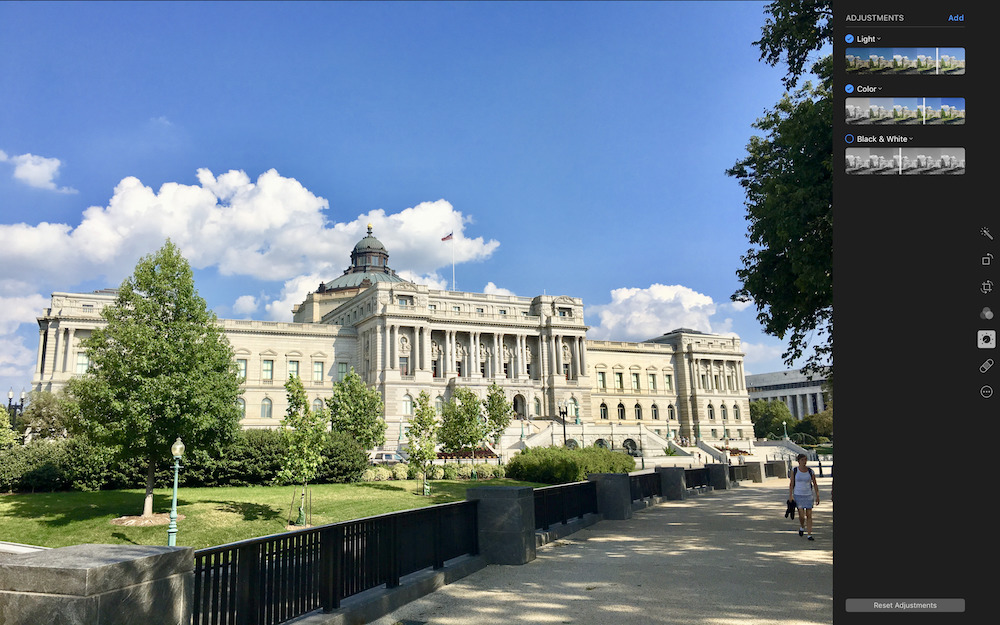
![]()
Tertiary political party apps volition need to brand some effort to present useful features in the Touch Bar, merely a diverseness are already working on functionality due immediately or later this year. Apple demonstrated initial developer back up for Adobe Photoshop and djay Pro, an a diverseness of other developers have also announced they'll be adding specialized back up for Bear upon Bar, including Microsoft's Office and Skype apps; photo editors Affinity Photo, Sketch and Pixelmator; video editor Da Vinci Resolve; Omni'due south productivity suite including OmniGraffle, OmniPlan, OmniFocus and OmniOutliner; journaling tool Twenty-four hours One; development text editor Coda; blogging tool Blogo and interior design modeling tool Alive Home 3D.
Overall, Touch Bar seems to be a lot smarter and thoughtful implementation of touch controls for a laptop compared to simply adding a touch screen to make the unabridged display actionable. I have several times reached out to tap something on a notebook screen later having worked on an iPad. Information technology would seem to be a natural and obvious evolution in notebook computing to make the screen touchable, and clearly Microsoft has bought into the "obviousness" of that in its decade of trying to promote Tablet PCs followed by some other several years of promoting bear on-based Windows vii, eight and 10.Touch Bar seems to exist a lot smarter and thoughtful implementation of touch controls for a laptop compared to simply calculation a touch screen to make the unabridged display actionable
However, most users don't see a touch screen PC every bit beingness very compelling or valuable, particularly after the novelty wears off. It's fatiguing and pulls your easily off the keyboard. Touch works best when its the primary interface (such equally on a phone or tablet) rather than simply being layered on peak of the conventional mouse-based desktop. The Touch Bar seems to do a amend job of bringing iOS-style touch to conventional notebooks than making the unabridged screen a touch surface.
Apple'south Impact Bar puts multitouch controls just higher up the keyboard, where they remain visible even as you touch type. The more than I utilize it, the more information technology seems that the dynamic — yet restrained — design of the Bear on Bar offers something of real value: it'southward non just the power to reach out and affect the existing display every bit a shortcut to choice with a pointing device. Instead, it presents a hot list of actions distilled downwards from the busy desktop interface.
Other examples include Contacts where the Touch Bar offers big like shooting fish in a barrel buttons for reaching the selected contact, with icons for calling, FaceTime or emailing. Tap the Edit button, and you become large buttons for adding a new phone number, email, birthday or address, later which you can immediately begin typing in the information. That's a quick alternative to mousing to a specific field and then returning to the keyboard or reaching out to affect pocket-size targets on a touchscreen monitor.
![]()
Bear on Bar gets thoughtful attention even from simple apps similar Contacts
Some of Apple tree's own apps take pretty bones support for the Touch Bar. In System Preferences, it would exist more useful if you lot could edit a listing of shortcuts to the Pref Panes you frequently admission. Certainly, in some apps the options presented in the Touch Bar are niggling more than a novelty and at the very worst a distraction.
However, there are useful shortcuts throughout even the arranged macOS apps, and the Pro apps Apple tree has demonstrated so far appear to brand smart application of the Touch Bar— in conjunction with the trackpad— in ways that promise to salvage veteran users a lot of fourth dimension when doing precise or repetitive tasks.
Apple'southward guidelines seek to keep the Impact Bar uncluttered and easy to apply, with generally minimal use of colorful graphics and animations outside of sliding controls in-and-out of focus and representation of screen content or editing results. Touching control buttons and using sliders and other features of the Impact Bar feels fast and fluid.
It'southward also noteworthy that Apple'due south own implementation of the Impact Bar is far more sophisticated and useful than what was imagined in rumors this summer, where the display strip was portrayed equally simply beingness a re-create of the carte du jour bar icons, and portrayed duplicative visualizations of on-screen progress bars and Siri animations, offering very little value to users.
In addition to a new generation body design, the 2016 MacBook Pros also debut a new processor architecture based on Intel'due south Skylake CPUs, the scrap designer'south sixth generation Core processor. A primary feature of the new scrap design is its ability to rapidly power down when computationally idle.
The xv inch model has two base of operations configurations: the first ($2399) using a two.half dozen GHz quad-core Intel Cadre i7 Skylake (6700HQ) with 6MB shared L3 cache (customizable to a 2.9 GHz Core i7 6920HQ with 8MB shared L3 cache for $300 more), and the 2nd ($2799) being a 2.7 GHz quad-core Intel Core i7 Skylake (6820HQ) with 8MB shared L3 cache (customizable to a two.9 GHz Cadre i7 6920HQ with 8MB shared L3 cache for $200 more). We tested the base version of the latter (a 2.vii GHz Cadre i7 6820HQ).
Geekbench four benchmarking returned a single core score of 4295 and a multiple core score of 13296. Note that dissimilar iOS mobile devices, the architecture and interface of macOS makes it easier to benefit from multiple threads on multiple cores, more than of the fourth dimension.

Note that despite non having had a major CPU upgrade since 2013, Apple tree's Mac Pro with 8 or 12 core Xeon processors remain 55-72 percent faster in multiple core benchmarks, while Apple's twelvemonth-old 27 inch 5K iMac with a desktop quad core Core i7 scores about 25 percent faster. That means users with an insatiable need for processing ability should consider Apple's non-mobile offerings. At the same time, mobile users can't exactly mutter that their super thin MacBook Pro is marginally slower at tiptop tasks than a desktop course machine plugged into the power main.
The latest MacBook Pro scores are in line with the highest end, custom configured MacBook Pros previously bachelor: last summer'due south models using "all-time" tier Intel's Crystalwell Core i7 CPUs that Apple offered.
And so rather than being a major leap in processor power, the latest MacBook Pro delivers similar operation to premium chips at a lower base price, in a lighter, thinner enclosure. The new MacBook Pro is half a pound lighter than previously, so beingness able to evangelize that slim package with similar performance to the loftier end— simply at a lower base of operations price — is a pretty impressive engineering accomplishment.
Once a perpetual driver of faster processing every year, Intel'south x86 architecture appears to be stuck in computational stasis. In office, that's intentional, as Intel focuses both on alternatives to raw speed (including the battery efficiency that's and then important in mobile machines, every bit highlighted in Intel's graphic below) likewise every bit alternative ways to achieve operation (including faster bus designs, back up for faster RAM and superior external interfaces), all of which contribute to better performance in means that a blazing fast CPU engine on its own can't equal. After all, information technology doesn't matter how fast your processor is running if you're struggling to get data in and out of the system.

Intel has been promoting power efficiency as a main CPU design goal
Apple, too, has focused on new ways to raise performance without simply relying on a monstrously fast CPU. Those initiatives largely marshal with Intel, including its support for the fastest power-efficient RAM supported past Intel'south Skylake chips (16GB of 2133 MHz, PC3-17000 LPDDR3), besides equally support for Thunderbolt 3 (offer massively fast 40 Gbps throughput for loftier speed peripherals, as well equally beingness the starting time single-cable solution supporting 5K external displays), and ultra fast internal PCIe SSD storage.Apple representatives noted that Skylake'due south back up for quad-core CPUs was a master reason for selecting that Intel architecture over the newer Kaby Lake microarchitecture, which doesn't nonetheless offer any four core versions
Apple tree has also been working to heighten multiple cadre CPU support in macOS, taking fuller advantage of the four core architecture of the Core i7. Apple tree representatives noted that Skylake'south support for quad-cadre CPUs was a chief reason for selecting that Intel architecture over the newer Kaby Lake microarchitecture, which doesn't notwithstanding offer any iv core versions.
The same issue of Intel failing to deliver a quad core version of is newest microarchitecture kept Apple from adopting Intel's newest Broadwell processors last year, and using Haswell fries instead.
Kaby Lake can also support more than than 16GB of RAM, but currently requires the utilise of less ability efficient RAM than the MacBook Pros were designed to apply. Then moving to Kaby Lake to get more RAM would non but involve lower bombardment life, but would besides lower high end performance, maxing out with dual core CPUs.
Apple tree has been criticized for the engineering decisions it made in the newest MacBook Pros, simply that criticism seems to be largely uninformed; those complaining about 16GB not being "pro enough" seem to have failed to catch the whole story.
Another major objective for Apple over the concluding few years has been to delegate more than processing tasks to the GPU. That effort has increased with the appearance of Metal on macOS. Metal originated on iOS, where it was intended to slash the CPU overhead required to gear up tasks for the GPU, whether graphical, or merely math optimized for calculation on a GPU core. On the Mac, Metal also helps to go on the GPU busy with less effort from the CPU, freeing general processing processor cores to exercise other tasks.
The benefits of the Metallic compages are harder to nowadays in benchmarks, because most graphics benchmarks seek to fully saturate the GPU without regard for how decorated the CPU is. Ideally, both the CPU and GPU are otherwise idle while running graphics benchmarks, but running benchmarks that way also buries the core intent of Metallic. In real world scenarios, OpenGL typically can't fully exploit the GPU because the CPU feeding information technology is too busy itself with OpenGL overhead and other not-graphical tasks.
Developers, still, report that using Metallic does help enormously by enabling them to more efficiently schedule more graphics operations on the GPU without bottlenecking the CPU. That allows games, for example, to assign more not-graphical operations such every bit physics calculations to the CPU while the GPU runs closer to existence fully utilized.
The new MacBook Pro pairs the basic Intel Hard disk Graphics 530 (on Intel's CPU package) with a dedicated AMD Radeon Pro 450 or 455 GPU with 2GB of its own RAM. There's also a $100 choice for an AMD Radeon Pro 460 paired with 4GB of GDDR5 memory, which Apple noted was a outset in whatsoever notebook. Annotation that it's a $200 choice on the lower end version of the 15 inch MacBook Pro.
Like previous models, macOS tin automatically actuate and switch to the dedicated GPU when necessary and autumn dorsum to integrated graphics to relieve energy. Apple states that the discreet Radeon Pro graphics on this generation MacBook Pro is up to 130 percent faster in 3D graphics over the previous models.
Forth with enhanced utilization of the GPU, some other cardinal operation bottleneck Apple has taken aim at is hard drive storage. Conventional hard drives utilize a spinning magnetic platter, which has long been cost constructive merely has a series of downsides in a notebook: they're large, they generate heat, they're potentially susceptible to impact shock and they're much slower than solid state storage drives (SSD) using flash memory chips.
Apple tree fully embraced SSD with MacBook Air back in 2008, making it the just pick. Since so, information technology has worked to develop faster technology and to bring the price of SSD storage down to make it competitive with spinning disks. While still significantly more than expensive than hard drives, SSD is then much faster that it makes a huge divergence in general throughput and is very noticeable in every user interaction from booting to opening apps to saving files.MacBook Pros put their SSD storage directly on the PCIe bus, enabling them to be materially faster than PC alternatives that utilise SATA interfaces
MacBook Pros put their SSD storage directly on the PCIe bus, enabling them to be materially faster than PC alternatives that utilise SATA interfaces. Apple tree has besides fully adopted Intel's Thunderbolt iii compages for exposing the high speed PCIe to external peripherals. Thunderbolt 3 supports up to forty Gbps file transfers, in addition to multiplexing DisplayPort signaling. Further, Apple uses the same USB-C connector for Thunderbolt three and and for USB 3.ane peripherals, too as for power input.
I connected an external 3TB USB three.0 mechanical hard drive, and using the Blackmagic Disk Speed Test app (which uses dissonance data to simulate real video transfers), I got 70 MBps (560 Mbps) write and xix.1 MBps (153 Mbps) read results. The upper limit for USB 3 is 480 Mbps. The upper limit for USB iii.1 is 5 Gbps. The System Information panel listed the continued external drive as being on the USB 3.1 Motorbus (I purchased it as a USB 3.0 device).
In comparison, the same drive barely scored 23 MBps (184 Mbps) write and 14.1 MBps (113 Mbps) read results on a MacBook Air using standard USB ii.0. That highlights how much difference the connexion technology makes, in add-on to the overall speed of the organization.
Thunderbolt 3 has an upper limit of xx Gbps per channel on two dissever buses. I did non take a Thunderbolt 3 storage arrangement to test. However, the internal 512GB SSD, like Thunderbolt, uses PCIe, the fastest autobus on the machine, without any intermediary protocol such as SATA to ho-hum things down. It is very fast, scoring 1875.four MBps (15,000 Mbps) in writes and consistently maxing out the benchmark app at its upper limit of 2,000 MBps (16,000 Mbps or 15 Gbps) for reads. That's actually fast.
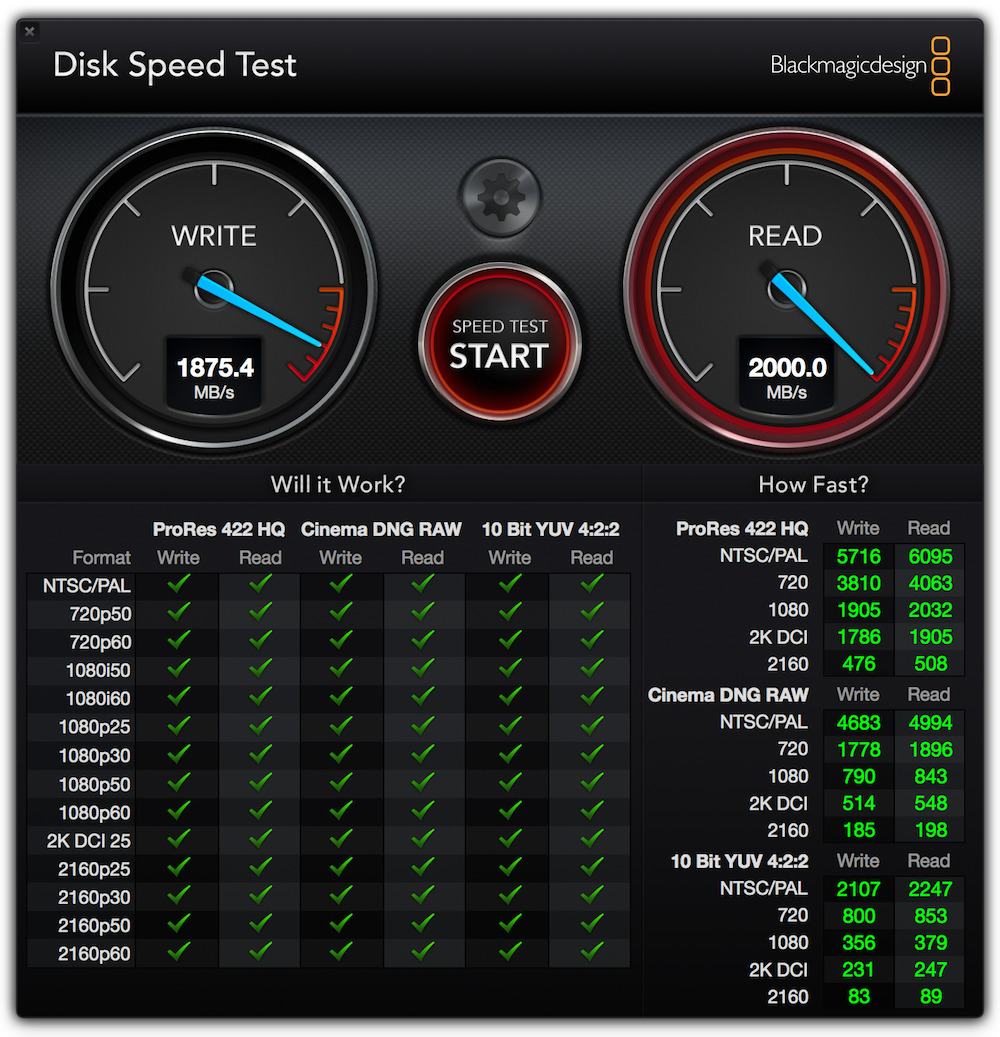
Apple tree outlines SSD sequential read speeds upwards to 3.ane GBps and sequential write speeds of ii.2 GBps, which is up to 50 pct faster than the previous generation of MacBook Pros. Yous can also now configure 2TB of SSD storage, although information technology'due south a very expensive selection.
Moving from the base 15-inch model's 256GB SSD costs $200 to get to 500 GB, $600 to upgrade to 1TB and $1400 to get to a 2TB SSD. The "improve" 15-inch model starts with a 512GB SSD, and costs $400 to get to 1TB and $1,200 to achieve 2TB.
Other PC vendors offering cheaper SSD options, but those are lower performance SATA III drives, an option Apple tree doesn't offering on its MacBook Pros. Other PCIe SSD components are priced similar to Apple (and are relatively hard to find, every bit the budget-oriented PC world sticks with SATA for cost savings).
It remains to be seen what touch on the upcoming Apple File System APFS will have on disk functioning. Currently still in beta, the modern new file system for macOS and Apple's other platforms promises to be "optimized for Flash/SSD storage and feature stiff encryption, copy-on-write metadata, space sharing, cloning for files and directories, snapshots, fast directory sizing, atomic safe-save primitives, and improved file organization fundamentals."
Past standardizing on the ultrafast PCIe bus for its SSD options, Apple has the ability to optimize its file organisation software in means that other platform vendors and their non-integrated partners tin't.
On top of being calorie-free, thin and fast, this twelvemonth's new MacBook Pro also improves its audiovisual specifications, adopting an improved, Wide Color Retina Display and a redesigned audio system with louder, broader sound along with three mics for improving FaceTime chats and Siri voice recognition.
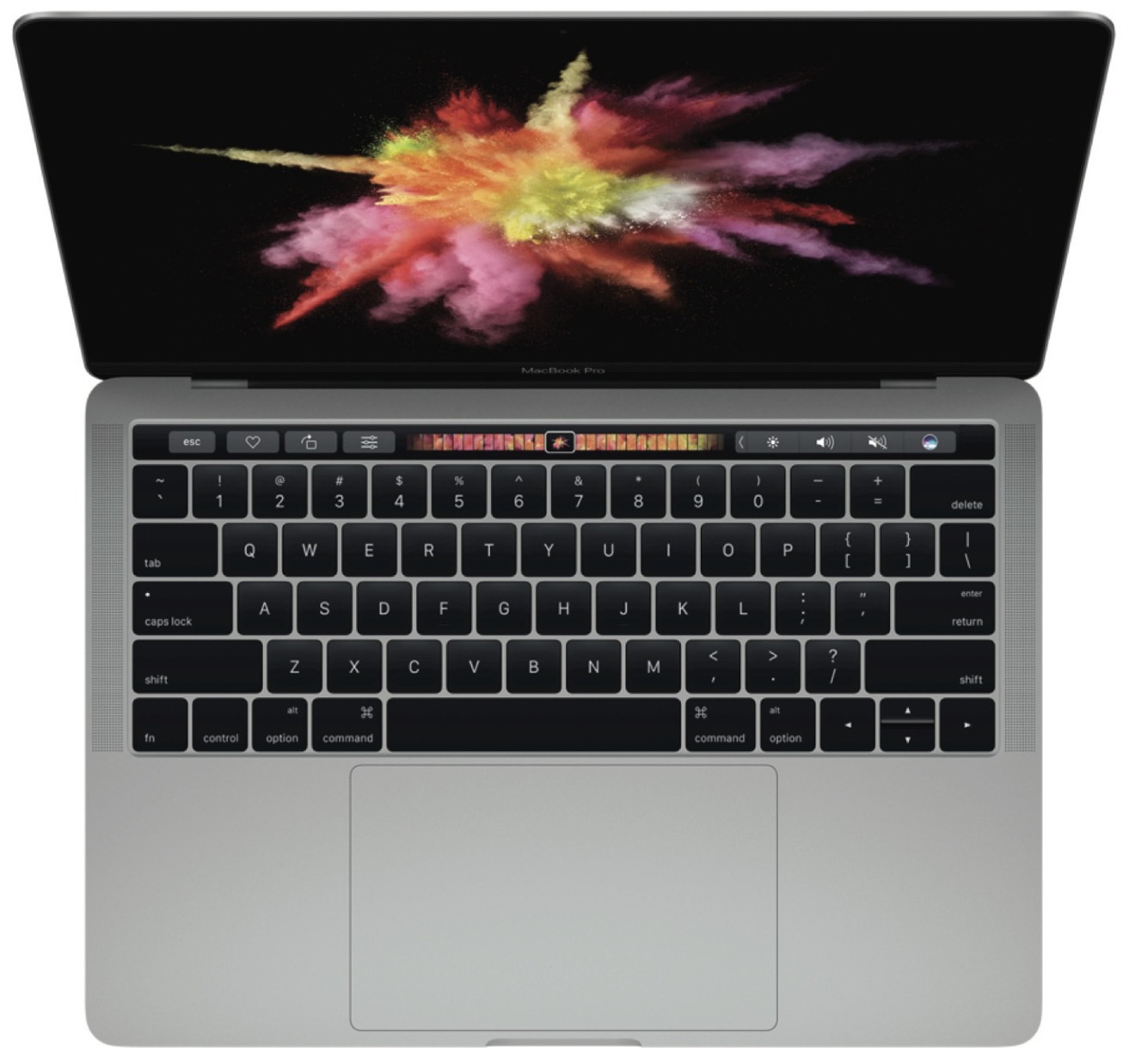
Apple tree first introduced support for the DCI P3 Broad Color gamut on its iPad Pro this summer, then expanded back up to its newest iPhone seven. Like both of those introductions, the new MacBook Pro retains the aforementioned pixel resolution (2880x1800) but improves its brightness by two-thirds (arriving at 500 nits, which Apple attributes to brighter LED illumination, an optimized lite guide panel and a larger pixel aperture) likewise equally increasing dissimilarity past an identical 2-thirds, resulting in deeper blacks and brighter whites.
The new support for Wide Color likewise ways the screen shows the full color spectrum captured by iPhone 7's cameras. The DPI P3 gamut presents 25 per centum more colors. The enhanced color gamut specification was developed for digital movie theatre, so information technology's not just your personal photographs that will be able to take advantage of its back up for Wide Color. In one case y'all get used to a Wide Colour display, it'southward hard to go back. Additionally, the new screen is 30 percent more than power efficient.
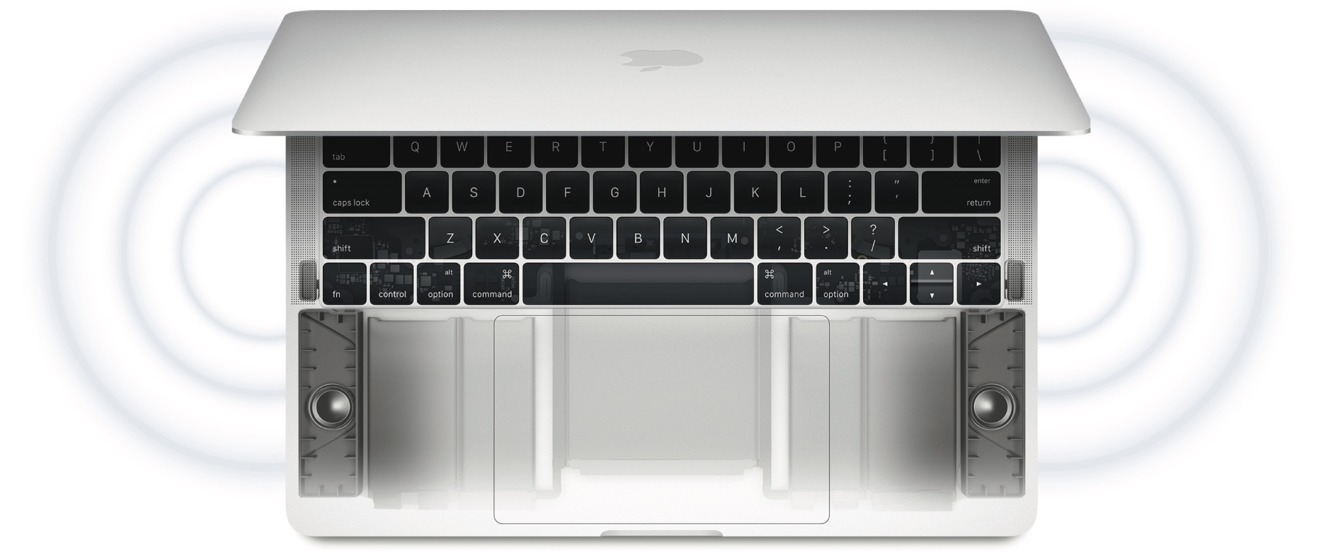
Apple tree's new speaker design for the 13 inch MacBook Pro
The new trunk design of the MacBook Pro also makes room for larger speakers. Apple says they create louder sound with twice the dynamic range, and that the positioning creates a greater stereo separation. I initially noticed this, only before I could do much testing, the review machine I used stopped producing audio entirely. Withal earlier that occurred I was actually surprised by the Mail commitment sound appearing to slide across my keyboard and fly into the ether.
Later I tried invoking Siri from the Touch Bar, audio returned and began working commonly. Well, normally where the new normal is really loud. At total volume, music playback fells very loud, well-nigh uncomfortably then in a quiet room. The very wide stereo imaging is a huge shift from my mono MacBook Air, where all the audio comes from ane side. The big MacBook Pro audio upgrade is a actually important new characteristic, and comes in tandem with larger, louder sound from Apple'due south other big 2016 releases, including the iPad Pro and iPhone 7
The sound quality is impressively crisp; Apple tree notes that the tweeters are pointed right at your face from both sides of the keyboard. The lower frequency woofers emit sound through the sides of the unit, reflecting from the surface you have it sitting on.
That means if you have information technology counterbalanced on your lap, the audio can lose some of its depth. On a desk-bound, the sound is immersive, wide, clear and impressively substantial, especially given the sparse outline of the machine. The big MacBook Pro audio upgrade is a really of import new feature, and comes in tandem with larger, louder sound from Apple'due south other big 2016 releases, including the iPad Pro and iPhone vii: Wide Colour, Wide Sound!
Ii of the most obvious visual differences of the new MacBook Pros, in one case y'all open it up, are the huge new trackpad and the ultra low contour keyboard. The trackpad represents the 2d generation of Forcefulness Bear upon on the MacBook Pro. The commencement version of Forcefulness Affect was the aforementioned size as previous trackpads, necessitated by the fact that it was installed into the beat out designed for the original, mechanical trackpad.
The clicking mechanism is gone, replaced (similar to the iPhone 7 Dwelling house Button) with a virtual click delivered by a vibration actuator behind it. Information technology feels very existent, like a perfectly counterbalanced button that'southward only too big to exist so precise if it were an actual button surface rather than an Force Touch on panel.
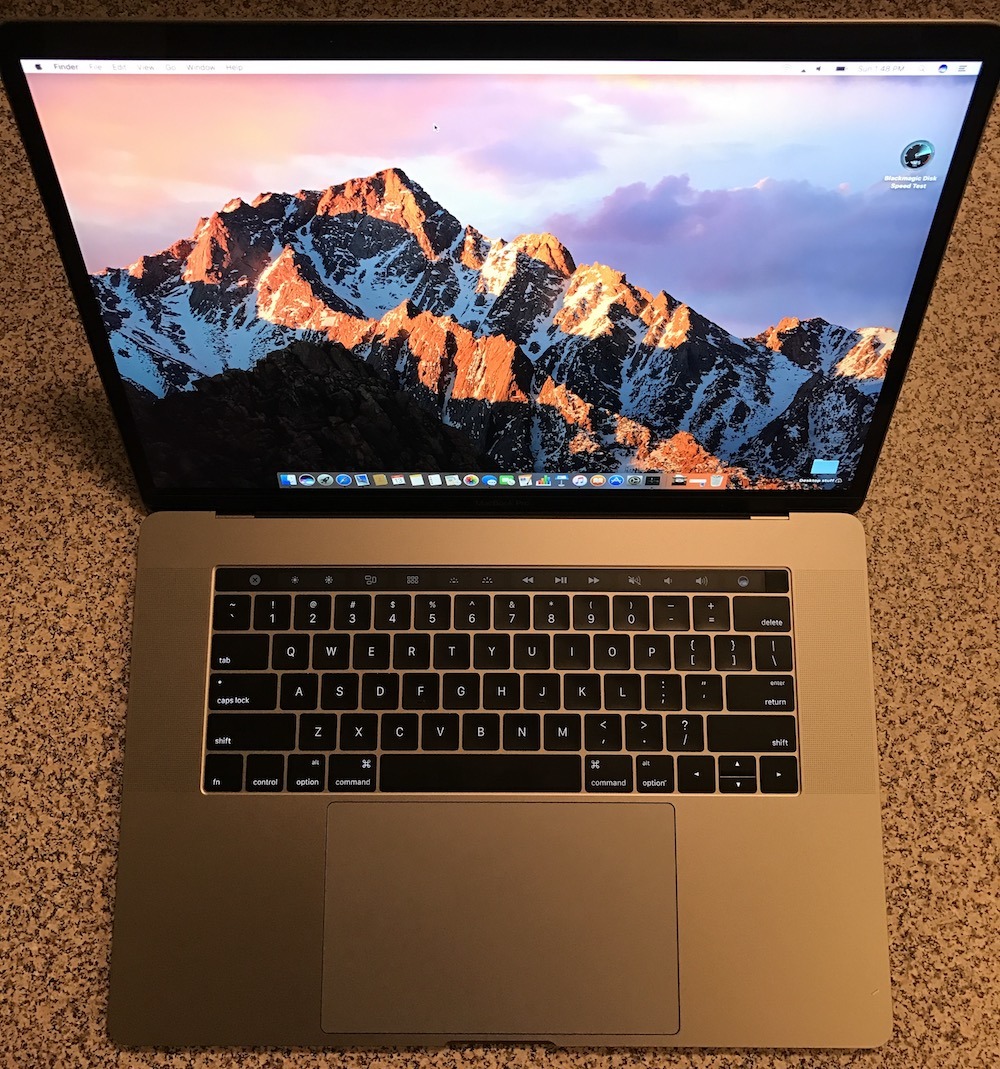
That'due south a large trackpad
Because the new design is no longer constrained past the physics of a hinged push button that depresses inward, information technology tin can be large. Apple fabricated it huge: twice as big equally the previous 15 inch MacBook Pro. The point? It's easier to click, drag and perform other gestures, fifty-fifty when starting from the middle of the trackpad. And while macOS hasn't introduced whatsoever new multitouch gestures specifically for the new trackpad, some of those existing ones make more sense now that the trackpad is so large.
For instance, a three or four finger + thumb pinch is easier to use to reveal the Desktop or to bring up the domicile page of apps on Launchpad. You can also more than naturally swipe in from the correct side with 2 fingers to reveal Notifications and widgets. Additionally, used in combination with buttons or other controls in the Bear on Bar, you tin can comfortably make selections across the much larger trackpad while picking unlike options most using your reverse hand.
The new MacBook Pro keyboard is the 2nd version of Apple'southward "butterfly" mechanism first introduced on the Retina MacBook. It'south improved, but at that place'south still very little travel in the keys. When I first started typing, I institute it felt both strange and flat and seemed to be louder when typing (in comparison with my MacBook Air).
Afterwards some typing, the keys chop-chop began to experience more familiar, although the tapping sound of the keyboard continues to be somewhat distracting. On a MacBook Air — or the visitor'south other conventional "scissor" design central switches — hit private keys is closer to silent, but the key caps themselves seem to jiggle around a flake equally you lot type. This less precise blueprint of the Air keyboard as well results in more lite leakage effectually the keys.
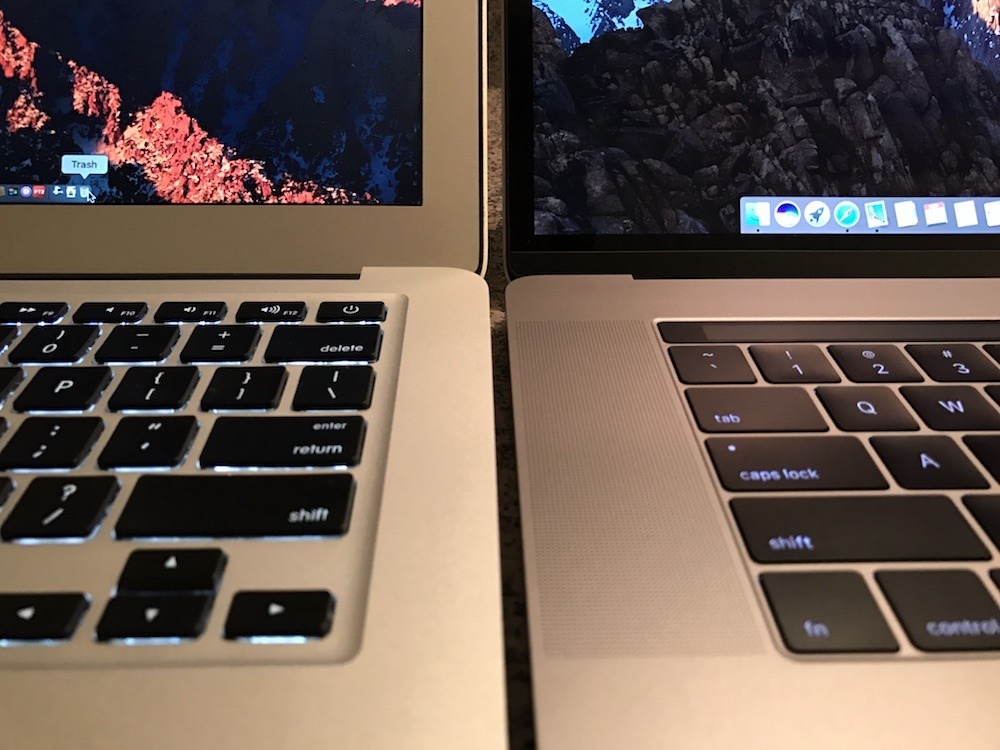
The previous MacBook Air keyboard leaks more than illumination around the keycaps.
In that location are subjective advantages to both, but I presently found the new keyboard comfortable to type on; moving back to a different keyboard now results in the earlier designs feeling strange.
The new MacBook Pro keyboard is thinner and flatter, and private keys don't feel like floating plastic caps; they experience closer to borer on a membrane. Keys are also closer together with less bare space between them. Having spent some time typing, I can at present say I like the new keyboard blueprint. It also serves an important contribution to the new automobile'due south remarkable thinness and portability.
Further, the new keyboard likewise closely integrates into the Touch Bar. Moving back to a non-Touch Bar machine feels particularly archaic, like a step back into the distant past. It's worth noting that if the keys were any more substantial and had a greater throw of motility, the hard, flat Touch Bar would feel less integrated.
Currently, the perfectly apartment Touch Bar feels a bit expressionless when you lot tap it later having banged at the concrete keys for a while. At that place's no haptic feedback, so information technology's the same as moving from a concrete keyboard to tapping on an iPad screen. The new keyboard therefore fits into a middle ground between a deeper keyboard throw and a totally apartment experience like that of typing on the glass of an iPad.
The new Impact Bar MacBook Pro in review
It's equally sparse as an Air and feels not much heavier, but packs all the Pro features Mac users are accustomed to at the higher stop: desktop class performance, broad expansion connectivity and super fast, larger capacity internal storage.


The new model also delivers a huge, spectacular Retina Display; peachy built-in sound and a large, authentic trackpad. The new keyboard is a reflection of its thinness, and paired with whizzy new Touch Bar and Bear on ID, the new machine delivers a satisfying, futuristic experience and is merely fun to use.
It remains to exist see how extensively third political party developers will take specialized, functional reward of the Bear upon Bar in their apps. However, even in apps that make no special utilise of the Affect Bar, Apple's design exposes common Command Strip features and Siri, and presents word and emoji suggestions as you blazon, making the new strip useful regardless.
What could have been ameliorate? If you're looking for an iMac-form auto that folds upwards and can exist carried off site, there'due south two problems standing in the way. Apple doesn't make thick heavy laptops anymore, clearly considering there wasn't that much interest in machines the size and weight of 17-inch MacBook Pros. Simply secondly, Intel doesn't fifty-fifty make the fries to power fast, quad core machines with vast amounts of RAM, fifty-fifty if Apple wanted to build a small batch of thick machines that didn't have very good bombardment life.
Given that reality, information technology's hard to criticize the design decisions behind the new MacBook Pro. Its CPU is not much faster than previous models, but that's largely considering of equally of import, parallel priorities of Intel, which is too aware of what kinds of features and form factors sell all-time. Ability efficiency, lite weight, a sparse pattern and fast connectivity are all preferable in the market place to simple clock speeds.
Along those same lines, while in that location's been criticism of Apple ditching old port types and even its ain MagSafe, the wholesale move to one plug for everything is actually amend for users overall, individuals who have divergent needs. It would not be better for the new MacBook Pro to be saddled with old connectors for USB-A and Thunderbolt 2 / Display Port. In fact, the edge walls of the new system are slimmer than the shell of an USB-A port itself (beneath, Apple's $nine USB-C to USB-A adapter).
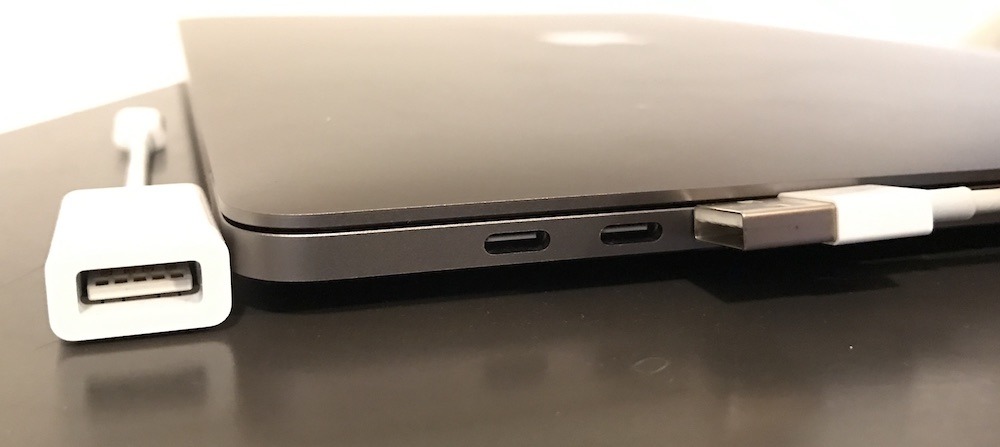
The new MacBook Pro edge wall is slimmer than the beat out of an USB-A port
Non having to visually line up the direction of a USB port is so much nicer than the original USB type plug, and the fact that a simple adapter might be needed in the transition — one that costs less than $10, or can be solved with the use of a USB-C hub, actually leaves this a trouble without an issue.
The new MacBook Pros besides now have more flexible USB-C power adapters (beneath, which can now be used to also rapidly power your iPhone, iPad or any other device rather than being solely useable as a MacBook charger). They can exist charged from either side, or draw power from a brandish or dock or power bank designed for USB-C devices, including solar panels like the Solartab C and other common external battery packs.
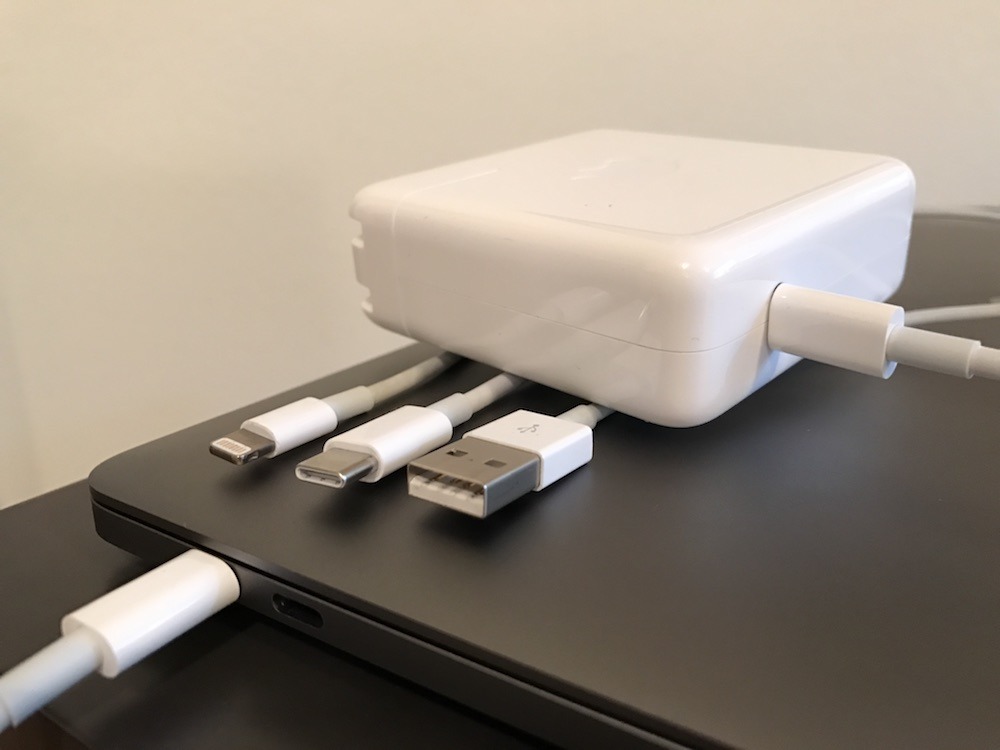
Lightning, USB-C and the original USB-A. The new power adapters tin also at present charge other USB devices, with an advisable cable, pregnant you lot but have to pack one adapter when traveling
The four ports all serve every bit both USB 3.1 ports and as high operation Thunderbolt 3 interfaces, and can support massive resolution external displays. A 5K display packs over 2.5 times as many pixels equally even the congenital-in Retina Brandish, and thanks to Thunderbolt 3, this automobile can ability ii of them. Information technology can also drive four 4K screens. You'll demand to be careful most selecting cables, as the physically identical USB-C used by USB 3 and Thunderbolt 3 has different requirements for cabling related to the speed and power a given cable tin support (just the same equally a given Category of Ethernet cabling).
However, the super flexible, uniform "everything on one connector" design of Thunderbolt 3 is clearly the future of cabling high performance peripherals, displays and external storage units. You'll virtually certainly need a new cablevision adapter for some of your existing devices, including your iPhone. Several low cost USB docks, some sporting an SD Carte reader, should adequately handle most user'due south backward compatibility needs.
One terminal issue that has gained lots of attention is that these MacBook Pro models and their upgrades are non inexpensive. Apple tree'south typically premium pricing is cypher new, merely as PC prices plummet and buyers begin to eye lower cost computing solutions— including Apple's own iPad Pro offerings — Apple's remaining holdout equally the notebook maker that sells significant volumes of machines well above $1,000 has anybody wishing that these machines were easier to afford.
Apple tree's 15-inch MacBook Pro with Touch Bar asks a steep price, just also delivers an incredible balance of power and efficiency, with industry leading support for technologies like PCIe SSD storage, Thunderbolt iii connectivity and Bone-integrated back up for Wide Colour gamut imaging. The Impact Bar — along with Touch ID — offers new conveniences and exposes features in new ways, assuasive an innovative style of immediate, iOS-like interaction on conventional notebooks.
These MacBook Pros weigh in at $2,400 to $ii,700 earlier adding premium upgrades such as a high capacity SSD or faster CPU and GPU, luxury prices that have your breath away. Withal, by all accounts it appears Apple knows its audience and will have no problem selling significant volumes of these loftier end machines.
Underneath its premium flagship, Apple tree has a number of lower priced options ranging from the entry MacBook Pro lacking a Touch Bar, to the even more than mobile but less capable Retina MacBook to the at present entry level non-Retina MacBook Air, and more economy priced iPad and iPad Pro offerings.
On the other hand, some professional and prosumer users with needs for more RAM and processing ability than this super thin notebook can deliver are either going to look for time to come Intel components to make it or invest in desktop machines — although both Apple's iMac and Mac Pro models are currently hanging in the wind without recent processor bumps and lacking any roadmap for some of the new technologies introduced on the latest MacBook Pros, including Thunderbolt three.
Only still: this light, thin powerhouse with an iOS-inspired touch interface panel, fast Bear on ID fingerprint authentication and an incredibly fast compages and connectivity options will spark excitement amongst those who can afford to pay Apple tree prices for Apple tree designed gear.
Score: 4 out of 5
![]()
How to Detect the Lowest Prices When Ownership
Before purchasing your new MacBook, brand sure to check out AppleInsider'due south Price Guides to find the everyman prices bachelor for your desired configuration and see which Apple authorized resellers currently have your desired model in stock.
Every bit of press time, new orders for these new MacBook Pros with Touch Bar are backlogged by 4 to 5 weeks through Apple's straight and indirect sales channels. Therefore, deals and discounting on the Affect Bar models have nonetheless to kick off in Apple's reseller channel. Still, about shoppers can even so save hundreds on their new MacBook Pro with Touch Bar by pre-ordering from an Apple authorized reseller who does not collect sales tax on orders shipped to most states.
For example, Apple tree authorized power reseller B&H Photo is currently taking pre-orders for both 13-inch MacBook Pros with Bear on Bar and 15" MacBook Pros with Touch Bar and volition but collect sales tax on orders shipped to a NY address. It besides offers an additional $50 discount on AppleCare extended protection plans when purchasing aslope a new MacBook Pro. B&H carries every possible configuration of these new MacBook Pros, all of which are cleanly organized in our Mac Cost Guide. The same set of pre-order links are besides repeated below for your convenience:
xv" MacBook Pros with Touch on Bar Pre-Orders @ B&H (No revenue enhancement outside NY)
15" (2.6GHz 16GB 256GB Radeon 450) in Gray for $2,399.00 ($192 off in tax outside NY)
15" (2.6GHz 16GB 256GB Radeon 450) in Silver for $2,399.00 ($192 off in tax outside NY)
15" (two.6GHz 16GB 256GB Radeon 460) in Grayness for $2,599.00 ($208 off in tax outside NY)
15" (ii.6GHz 16GB 256GB Radeon 460) in Argent for $2,599.00 ($208 off in taxation outside NY)
15" (2.6GHz 16GB 512GB Radeon 450) in Grayness for $two,599.00 ($208 off in tax exterior NY)
15" (2.6GHz 16GB 512GB Radeon 450) in Silver for $2,599.00 ($208 off in tax outside NY)
xv" (two.6GHz 16GB 512GB Radeon 460) in Gray for $2,799.00 ($224 off in tax outside NY)
fifteen" (2.6GHz 16GB 512GB Radeon 460) in Argent for $2,799.00 ($224 off in tax exterior NY)
15" (2.6GHz 16GB 1TB Radeon 450) in Grey for $2,999.00 ($240 off in tax exterior NY)
15" (2.6GHz 16GB 1TB Radeon 450) in Silvery for $2,999.00 ($240 off in tax outside NY)
15" (two.6GHz 16GB 1TB Radeon 460) in Grayness for $3,199.00 ($256 off in tax outside NY)
15" (2.6GHz 16GB 1TB Radeon 460) in Silver for $3,199.00 ($256 off in revenue enhancement exterior NY)
xv" (2.6GHz 16GB 2TB Radeon 450) in Gray for $3,799.00 ($304 off in taxation outside NY)
15" (ii.6GHz 16GB 2TB Radeon 450) in Silverish for $iii,799.00 ($304 off in tax outside NY)
15" (two.6GHz 16GB 2TB Radeon 460) in Gray for $3,999.00 ($320 off in tax outside NY)
15" (two.6GHz 16GB 2TB Radeon 460) in Silver for $3,999.00 ($320 off in taxation outside NY)
15" (2.7GHz 16GB 512GB Radeon 455) in Greyness for $2,799.00 ($224 off in tax exterior NY)
15" (2.7GHz 16GB 512GB Radeon 455) in Silver for $2,799.00 ($224 off in revenue enhancement outside NY)
15" (2.7GHz 16GB 512GB Radeon 460) in Gray for $2,899.00 ($232 off in tax outside NY)
fifteen" (2.7GHz 16GB 512GB Radeon 460) in Silver for $2,899.00 ($232 off in revenue enhancement outside NY)
xv" (2.7GHz 16GB 1TB Radeon 455) in Gray for $3,199.00 ($256 off in tax outside NY)
xv" (ii.7GHz 16GB 1TB Radeon 455) in Argent for $3,199.00 ($256 off in revenue enhancement outside NY)
15" (2.7GHz 16GB 1TB Radeon 460) in Gray for $3,299.00 ($264 off in tax outside NY)
fifteen" (2.7GHz 16GB 1TB Radeon 460) in Silver for $three,299.00 ($264 off in tax exterior NY)
15" (two.7GHz 16GB 2TB Radeon 455) in Gray for $iii,999.00 ($320 off in revenue enhancement outside NY)
15" (2.7GHz 16GB 2TB Radeon 455) in Silverish for $three,999.00 ($320 off in revenue enhancement outside NY)
xv" (2.7GHz 16GB 2TB Radeon 460) in Gray for $iv,099.00 ($328 off in tax outside NY)
15" (2.7GHz 16GB 2TB Radeon 460) in Silver for $four,099.00 ($328 off in tax outside NY)
15" (2.9GHz 16GB 256GB Radeon 450) in Gray for $2,699.00 ($216 off in tax outside NY)
xv" (2.9GHz 16GB 256GB Radeon 450) in Silver for $two,699.00 ($216 off in tax outside NY)
15" (2.9GHz 16GB 256GB Radeon 460) in Gray for $2,899.00 ($232 off in tax outside NY)
xv" (2.9GHz 16GB 256GB Radeon 460) in Silver for $ii,899.00 ($232 off in tax exterior NY)
xv" (two.9GHz 16GB 512GB Radeon 450) in Greyness for $2,899.00 ($232 off in revenue enhancement exterior NY)
fifteen" (two.9GHz 16GB 512GB Radeon 450) in Silver for $ii,899.00 ($232 off in tax outside NY)
fifteen" (2.9GHz 16GB 512GB Radeon 455) in Gray for $2,999.00 ($240 off in revenue enhancement outside NY)
15" (2.9GHz 16GB 512GB Radeon 455) in Silver for $2,999.00 ($240 off in taxation exterior NY)
15" (ii.9GHz 16GB 512GB Radeon 460) in Gray for $iii,099.00 ($248 off in tax outside NY)
15" (2.9GHz 16GB 512GB Radeon 460) in Silver for $3,099.00 ($248 off in tax outside NY)
xv" (2.9GHz 16GB 1TB Radeon 450) in Grayness for $3,299.00 ($264 off in tax outside NY)
15" (2.9GHz 16GB 1TB Radeon 450) in Silver for $3,299.00 ($264 off in taxation outside NY)
15" (two.9GHz 16GB 1TB Radeon 455) in Gray for $3,399.00 ($272 off in tax outside NY)
fifteen" (2.9GHz 16GB 1TB Radeon 455) in Argent for $3,399.00 ($272 off in taxation outside NY)
xv" (2.9GHz 16GB 1TB Radeon 460) in Gray for $3,499.00 ($280 off in tax exterior NY)
15" (2.9GHz 16GB 1TB Radeon 460) in Silver for $3,499.00 ($280 off in tax outside NY)
fifteen" (2.9GHz 16GB 2TB Radeon 450) in Gray for $4,099.00 ($328 off in tax outside NY)
15" (two.9GHz 16GB 2TB Radeon 450) in Silvery for $4,099.00 ($328 off in tax exterior NY)
15" (2.9GHz 16GB 2TB Radeon 455) in Gray for $iv,199.00 ($336 off in tax outside NY)
xv" (2.9GHz 16GB 2TB Radeon 455) in Silver for $4,199.00 ($336 off in tax outside NY)
xv" (two.9GHz 16GB 2TB Radeon 460) in Gray for $4,299.00 ($344 off in tax outside NY)
15" (ii.9GHz 16GB 2TB Radeon 460) in Silver for $four,299.00 ($344 off in revenue enhancement outside NY)
AppleCare for 15" MacBook Pros
You tin hands tack on an AppleCare extended protection programme to these MacBooks for the discounted rate of $299 ($fifty off) by selecting the AppleCare option immediately after y'all press the "Add together to Cart" button on B&H's website. Or just utilize this link.
Source: https://appleinsider.com/articles/16/11/14/review-apples-late-2016-15-macbook-pro-with-touch-bar
0 Response to "Apple 154 Macbook Pro With Touch Bar (Late 2016 Space Gray) Reviews"
Post a Comment